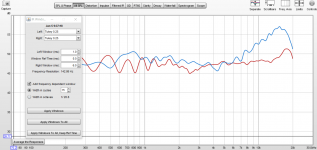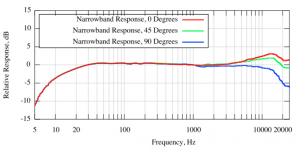I got a hold of some Kali LP6 monitors today that a friend let me borrow. My data on those tells me that my mic is fine, but it just raises more questions. Not a clue what to think anymore.

For what it's worth here are c-notes overlaid with Kali LP6. PE has responded and simply said that it's my environment which is definitely false. If it were, every other speaker I've measured would exhibit something similar yet the C-notes are the only speaker out of 4 that I have that exhibit this issue. At this point I'm assuming that I will not get a resolution on this and I'm going to have to trust my own data along with my ears and say the c-notes indeed to have a rising response issue. I will probably just give these things away because at this point I'm so burnt out on this whole issue that I don't even want to listen to them.

Looking at your SPL curves, they show a lot of detail at low frequencies (say at 400 Hz and lower). This tells me you're not using gated/anechoic measurements. Your data will largely be determined by the room.
I'd suggest that you (a) use gated measurements to get anechoic data and (b) determine the dispersion and power response to get a more meaningful idea of the sonic characteristics of your speakers.
I'd suggest that you (a) use gated measurements to get anechoic data and (b) determine the dispersion and power response to get a more meaningful idea of the sonic characteristics of your speakers.
Looking at your SPL curves, they show a lot of detail at low frequencies (say at 400 Hz and lower). This tells me you're not using gated/anechoic measurements. Your data will largely be determined by the room.
I'd suggest that you (a) use gated measurements to get anechoic data and (b) determine the dispersion and power response to get a more meaningful idea of the sonic characteristics of your speakers.
These weren't taken in room but outdoors. I admit I usually have them much higher up but just had them on 32" stands for these tests.
I applied these gating settings, are they correct or do I have them set wrong for this test?
Attachments
32" is about 0.8 m, so the floor is still pretty close. Depending on the speaker-microphone distance, the floor echo will not be delayed by very much. You'll have to look at the time-domain response to see where/when it is.
I don't see what this would have to do with the top end which is where my issue is.32" is about 0.8 m, so the floor is still pretty close. Depending on the speaker-microphone distance, the floor echo will not be delayed by very much. You'll have to look at the time-domain response to see where/when it is.
I went ahead and measured the tweeter and xover components one by one, you can get the .mdat and mic cal file here.
https://drive.google.com/file/d/1kg0O3cXV8qkI5IKsI3tRA0zQ_b9orS34/view?usp=share_link
https://drive.google.com/file/d/1kg0O3cXV8qkI5IKsI3tRA0zQ_b9orS34/view?usp=share_link
Can you provide the data in a more accessible format? A TMD file of the impulse response might be useful.
Can you provide the data in a more accessible format? A TMD file of the impulse response might be useful.
I can't imagine anything more accessible than REW for this data set so I'm gonna have to say no on that one, you can view the IR's of the data in REW.
Do you really expect me to install REW just so I can help you to make sense of your data? I would have hoped you'd export your data to a format that is accessible to other software packages. But you don't have to, and I don't have to.
Do you really expect me to install REW just so I can help you to make sense of your data? I would have hoped you'd export your data to a format that is accessible to other software packages. But you don't have to, and I don't have to.
I really don't expect you to do anything. Your time is yours to do what you wish.
Can we maybe keep the tone lighter please, having just experience a loss in the family, attitudes like this really bother me. These are speakers, it's audio, it's meant to be fun and a learning experience. Please be kind to each other.
Last edited:
Here are some ASR measurements of the C-Notes, with no sign of your problem.
https://www.audiosciencereview.com/...arts-express-diy-c-note-speaker-review.12693/
If you look at this measured EMM-6 response (0 degrees), it looks like your C-Note measurements with a smaller peak.
https://www.hifizine.com/2012/09/da...microphone-calibrated-by-cross-spectrum-labs/
https://www.audiosciencereview.com/...arts-express-diy-c-note-speaker-review.12693/
If you look at this measured EMM-6 response (0 degrees), it looks like your C-Note measurements with a smaller peak.
https://www.hifizine.com/2012/09/da...microphone-calibrated-by-cross-spectrum-labs/
Attachments
Last edited:
shouldn't the kali lp6 also exhibit a similar rise in hf then with the mic?Here are some ASR measurements of the C-Notes, with no sign of your problem.
https://www.audiosciencereview.com/...arts-express-diy-c-note-speaker-review.12693/
If you look at the measured EMM-6 mic response, it looks much like your C-Note measurements.
https://www.hifizine.com/2012/09/da...microphone-calibrated-by-cross-spectrum-labs/
Maybe the speaker has changed since the ASR measurements, or the tweeter has variability issues.
They measured my tweeter against an older sample and no change.Maybe the speaker has changed since the ASR measurements, or the tweeter has variability issues.
it is not clear if you have a flat frequency and phase response with a physical loopback before starting acoustic testsI have two interfaces I've tried, a motu m4 and rme babyface. They both give me the same results, I really don't think it's my gear.
- Home
- Design & Build
- Equipment & Tools
- Weird measurement quirk

